byu777 In memoriam: Brenda Fajardo, visual artist, educator, and cultural advocate
Updated:2024-10-25 04:09 Views:157
At 84 years old, artist and educator Brenda Fajardo (Feb. 18, 1940-Sept. 14, 2024) has left behind an indelible legacy in the realm of Philippine visual arts.
Known for her intricate works that intertwined folklore and history, Fajardo used her craft to reflect the Filipino grappling for identity and self-determination in the context of colonial history—all for greater social causes and, more often than not, addressing women’s issues as well.
Fajardo’s artistic and academic work focused on the aesthetics of poverty and the art of the people, using visual storytelling to reflect the struggles and triumphs of Filipino society.
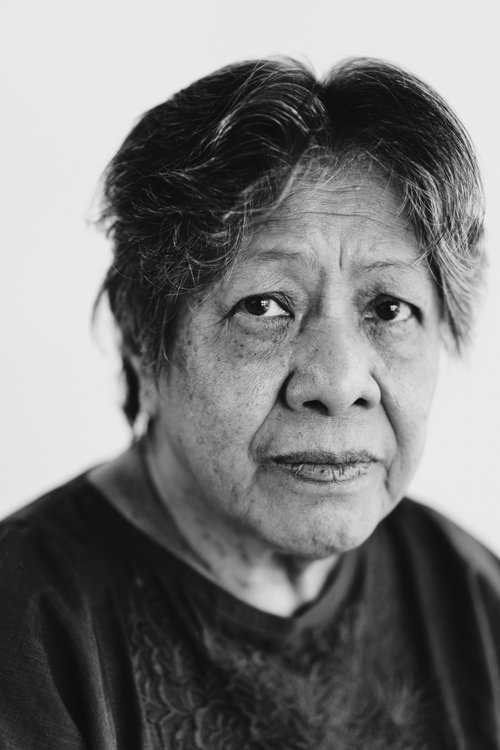 Photo from Tin-aw art gallery
Photo from Tin-aw art gallery
As an educator, the professor emerita of the University of the Philippines guided generations of artists in the school known for its stellar art education programs.
“She was the reason I shifted to the humanities in UP. I was previously a Spanish major… As an artist and cultural worker, Brenda Fajardo inspired a wide range of practitioners in the field of the visual arts and theater and the other disciplines of the entire creative ecology,” says acclaimed curator, critic, and educator Patrick Flores.
“Her prints, drawings, and paintings were distinct in terms of technique and discourse, shaped by the graphic discipline, a popular folk sensibility, and a sensitive awareness of history and a possible future. She created, together with peers around the islands and beyond, the conditions for the art of women and the regions to claim their necessary presence. She was a teacher of art, a professor of the humanities, and a scholar of folk culture. She was the quintessential artist-thinker-leader.”
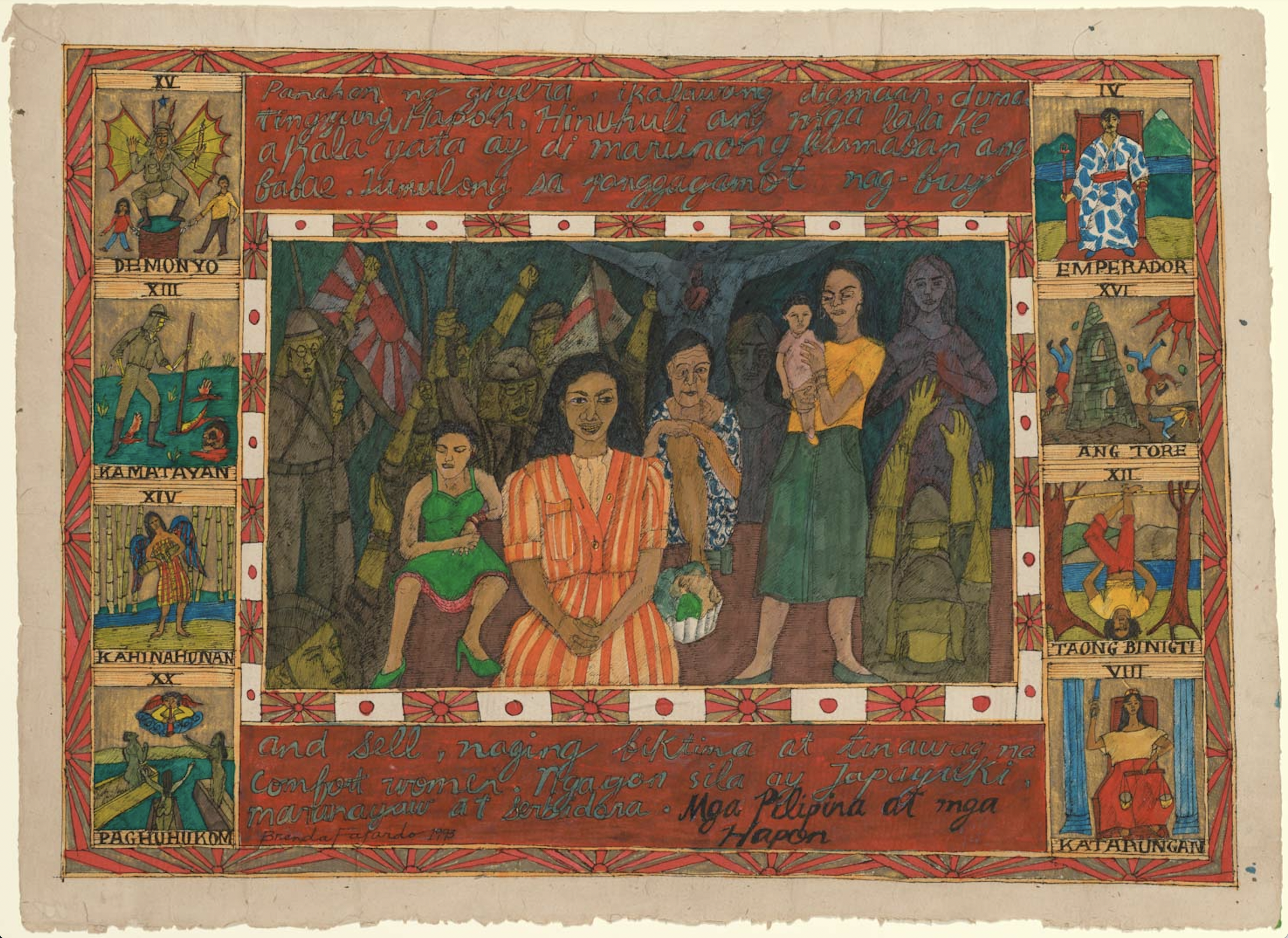 Brenda Fajardo, “Mga Pilipina at mga Hapon (Filipino women and the Japanese) (from ‘Cards of life – Women’s series’)” pen and ink with gold leaf on handmade paper, 52.5 x 72 cm. 1993. Photo from Queensland Art Gallery
Brenda Fajardo, “Mga Pilipina at mga Hapon (Filipino women and the Japanese) (from ‘Cards of life – Women’s series’)” pen and ink with gold leaf on handmade paper, 52.5 x 72 cm. 1993. Photo from Queensland Art Gallery
Because of her multifaceted career, Fajardo received numerous prestigious accolades throughout her life. In 1992, she was honored with the prestigious Thirteen Artists Award by the Cultural Center of the Philippines. She later received the Centennial Award for the Arts in 1998 and in 2012, she was awarded the Gawad CCP Para sa Sining for Visual Arts, further cementing her legacy in the world of Philippine art.
Early life
Born in Manila in 1940, Fajardo initially dreamed of becoming a professional dancer. However at the age of 14, her aspirations were cut short when she was diagnosed with rheumatic fever. Encouraged by her mother to pursue another creative outlet, she began studying art under the guidance of renowned Filipina artist Araceli Dans.
In an interview with the Cultural Center of the Philippines, Fajardo reflects on her early life. “Labinlimang taong gulang ako noong nagsimula ang aking interes sa kultura at sining. Ang nanay ko, si Libertad Villanueva Fajardo, ang isang mananaliksik ng Visayan folk dance sa aming probinsya ng Negros Occidental.”
This familial influence became a huge mover in her lifelong dedication to research, teaching, and creating art.
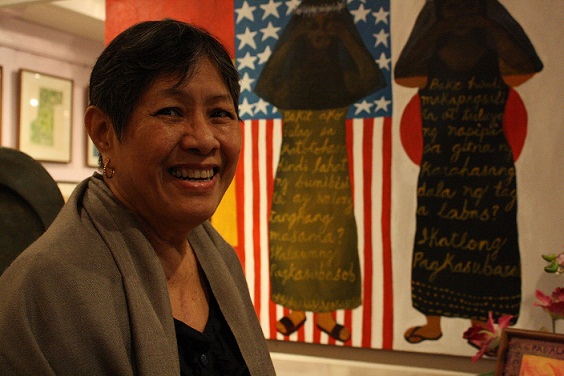 Photo from Vera Files
Photo from Vera Files
In 1959, Fajardo finished a degree in agriculture from the University of the Philippines Los Baños before pursuing a master’s degree in art education at the University of Wisconsin-Madison.
Despite her initial foray into agriculture, her passion for the arts persisted in taking center stage. During her time in Wisconsin, Fajardo discovered a passion for printmaking.
As soon as she returned to the Philippines, she went to the studio of Manuel Rodriguez Sr., whom she fondly recalls as Mang Maning. He taught printmaking at contemporary graphic arts workshops at a time when printmaking was uncommon in the Philippines.
“Ang printmaking ay bagong-bago noong panahon na ’yon dahil hindi ito ’yung pangunahing medium. Bago ang aktwal na print, kailangang magpasya ang isang printmaker sa bilang ng edisyon at magtrabaho lamang sa loob ng oras na pinapayagan sa studio. Ngunit kapag nagtratrabaho ako, madalas kong nakakalimutan ang oras. Mga print ang karamihan ng aking mga likhang sining noon.”
“Nagustuhan ko kung paano mailalapat ang scientific na pagsasanay sa isang napaka-disiplinado at mahabang proseso ng sining. Tapos ang kalabasan nito, kakaiba at malikhain pa rin. Pagpapahayag ng aking kaisipan ang mga gawaing ito. Hindi ko na iniisip ang iba kong artwork kapag gumawa ako ng print,” the artist recounts.
Her tarot card series
Fajardo gained widespread recognition for her “tarot card” series, where she combined traditional tarot symbols with Philippine history and social themes, creating powerful narratives that explored the nuances and interactions of identity, power, and resistance.
 Brenda Fajardo, “Baraha ng buhay pilipino: Major Arcana III” acrylic on canvas, 90 x 90 cm. 2005. Photo from Aware
Brenda Fajardo, “Baraha ng buhay pilipino: Major Arcana III” acrylic on canvas, 90 x 90 cm. 2005. Photo from Aware
Her renditions were often carnivalesque in a sense, indulging a folk aesthetic distinct to the Philippines—a “reading” of Filipino history with creatively designed characters like the Fool and Hanged Man as well as royal figures, reframed in a Filipino context. Fajardo also incorporated Indigenous and Muslim Filipinos as well as popular figures of men and women from various eras.
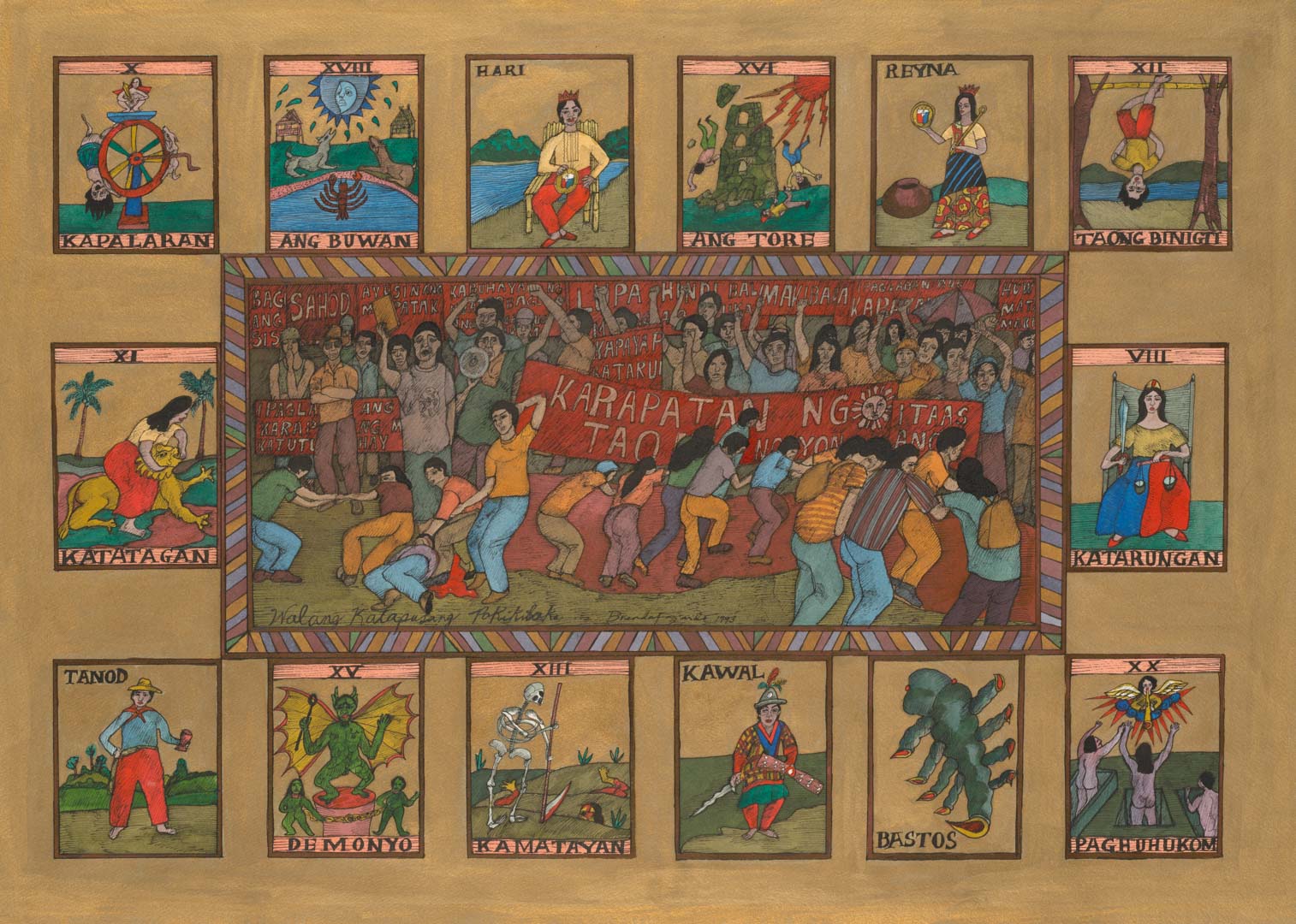 Brenda Fajardo, “Walang Katapusang Pakikibaka (Never ending struggle)” pen and ink with watercolour and gold pigment on paper, 54 x 75 cm. 1993. Photo from Queensland Art Gallery
Brenda Fajardo, “Walang Katapusang Pakikibaka (Never ending struggle)” pen and ink with watercolour and gold pigment on paper, 54 x 75 cm. 1993. Photo from Queensland Art Gallery
These works created their own universes through “readings” that seemed to divine the destiny of the Philippines—just as the mystic practice does, but now farther from the occult and instead grounded in Philippine history. Echoing her practice as an educator, her artwork made critical readings of the state of the country more necessary, from its history and present to the future.
Her works were exhibited in venues around the world, including Singapore, Cuba, Brisbane, and Paris, growing Fajardo’s career in international acclaim.
Initiatives in the vein of cultural service
Besides teaching and art-making herself, Fajardo was consistently active in organizations and initiatives rooted in service, with missions to better society and culture in the country.
She co co-founded the all-women art collective Kasibulan alongside Filipina visual artists Anna Fer, Julie Lluch, and Imelda Cajipe Endaya. The group was dedicated to promoting and empowering both women’s art and women’s advocacy.
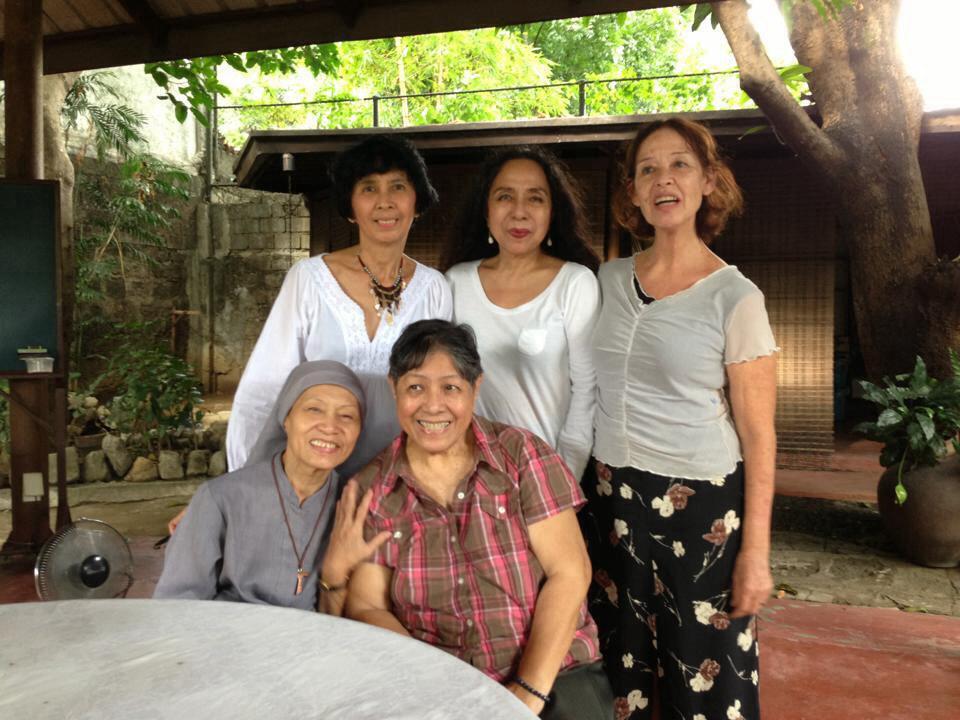 Seated: Sister Ida Bugayong, Brenda Fajardo. Standing: Imelda Cajipe Endaya, Julie Lluch, and Anna Fer. Photo from Kasibulan Facebook page
Seated: Sister Ida Bugayong, Brenda Fajardo. Standing: Imelda Cajipe Endaya, Julie Lluch, and Anna Fer. Photo from Kasibulan Facebook page
Fellow artist Endaya reminisces, “I met Brenda when I was a fresh college graduate who admired her etchings inspired by Larry Rivers. When I became a member of the print association where she was secretary treasurer, I soon inherited her post. Brenda was a great example of a responsible artist and I learned much from her organizing and educating work. From thene we became friends and she was a big sister to me.”
Fajardo was the founder of the Baglan Community Cultural Initiatives, a program aimed at nurturing cultural heritage in local communities. Her contributions extended to theater, as one of the pioneers of the Philippine Educational Theater Association in the late 1960s, an institution that has played a pivotal role in the development of contemporary Filipino theater.
READ: ‘The Half-Life of Marie Curie’ celebrates women’s all-encompassing power
Sought after for her astute guidance, Fajardo has been an adviser to the National Committee on Culture and the Arts, where she has helped shape policies for cultural preservation and education.
**
Her multifaceted career continues to inspire future generations, highlighting the deep connections between art, culture, and social justice.
Art writer and curator Patrick de Veyra reflects, “She was the keynote speaker during my high school graduation. I remember her speaking about the importance of DNA in art. She spoke about the rich images and narratives in Philippine folk art and Indigenous culture.”
Working tirelessly to elevate marginalized voices, Fajardo championed causes that merged artistic practice with social responsibility.
Her life’s work continues to inspirebyu777, as a reminder of the artist’s role in shaping and reflecting the national consciousness.